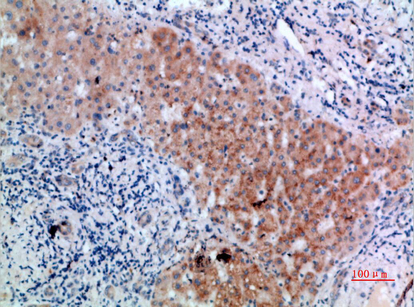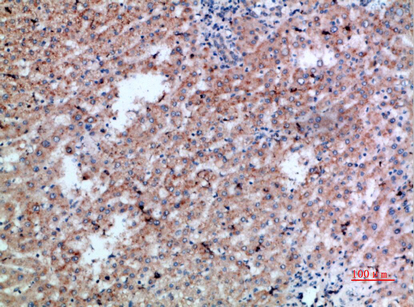

| WB | 咨询技术 | Human,Mouse,Rat |
| IF | 咨询技术 | Human,Mouse,Rat |
| IHC | 1/50-1/100 | Human,Mouse,Rat |
| ICC | 技术咨询 | Human,Mouse,Rat |
| FCM | 咨询技术 | Human,Mouse,Rat |
| Elisa | 1/10000 | Human,Mouse,Rat |
| Aliases | CMRF35-like molecule 7; CLM-7; CD300 antigen-like family member B; CMRF35-A2; Immune receptor expressed on myeloid cells 3; IREM-3; Leukocyte mono-Ig-like receptor 5; Triggering receptor expressed on myeloid cells 5; TREM-5; CD antigen CD300b |
| Entrez GeneID | 124599 |
| Host/Isotype | Rabbit IgG |
| Antibody Type | Primary antibody |
| Storage | Store at 4°C short term. Aliquot and store at -20°C long term. Avoid freeze/thaw cycles. |
| Species Reactivity | Human |
| Immunogen | Synthetic peptide from human protein at AA range: 61-110 |
| Formulation | Purified antibody in PBS with 0.05% sodium azide,0.5%BSA and 50% glycerol. |
+ +
以下是关于CD300b抗体的3篇代表性文献的简要总结:
1. **文献名称**:*CD300b regulates NLRP3 inflammasome activation and pyroptosis in macrophages*
**作者**:Li Y, et al.
**摘要**:该研究揭示了CD300b抗体通过阻断CD300b受体与脂质配体相互作用,抑制NLRP3炎症小体活化,从而减少巨噬细胞焦亡,为炎症性疾病治疗提供了潜在靶点。
2. **文献名称**:*Targeting CD300b in a murine model of sepsis-induced acute lung injury*
**作者**:Garcia-Cuesta EM, et al.
**摘要**:文章表明,使用CD300b中和性抗体可减轻脓毒症小鼠模型中的急性肺损伤,其机制与下调促炎细胞因子(如TNF-α和IL-6)及抑制中性粒细胞过度浸润相关。
3. **文献名称**:*Structural basis of CD300b antibody recognition in modulating immune responses*
**作者**:Kumar S, et al.
**摘要**:通过冷冻电镜技术解析了CD300b抗体与受体结合的分子结构,阐明其特异性结合表位,为开发靶向CD300b的抗体药物(如自身免疫疾病治疗)提供了结构生物学依据。
**备注**:若需具体文献年份或期刊信息,建议通过PubMed/Google Scholar输入关键词(如"CD300b antibody")筛选近5年高被引论文。
CD300b, a member of the CD300 family of immunoregulatory receptors, is a transmembrane protein predominantly expressed on myeloid cells such as monocytes, macrophages, and dendritic cells. Belonging to the immunoglobulin superfamily, CD300 receptors play critical roles in modulating immune responses by recognizing lipid-based ligands exposed on stressed or infected cells. CD300b specifically binds phosphatidylserine (PS), a phospholipid typically localized to the inner leaflet of cell membranes but externalized during apoptosis or pathological conditions like viral infection. This interaction enables CD300b to act as a sensor for cellular stress, facilitating immune surveillance and clearance of damaged cells.
Functionally, CD300b can trigger activating or inhibitory signals depending on its association with adaptor proteins like DAP12 or FcRγ. Studies suggest it regulates inflammation by balancing pro- and anti-inflammatory cytokine production, influencing outcomes in sepsis, autoimmune diseases, and cancer. For instance, CD300b engagement may enhance phagocytosis of apoptotic cells while dampening excessive inflammation. Conversely, its dysregulation has been linked to chronic inflammatory disorders.
CD300b-specific antibodies are valuable tools for studying receptor-ligand dynamics and therapeutic development. In preclinical models, antibody-mediated modulation of CD300b signaling shows potential in redirecting immune responses—blocking CD300b could mitigate sepsis-related hyperinflammation, while agonist antibodies might boost antitumor immunity. However, challenges remain in understanding context-dependent signaling and optimizing clinical translation. Ongoing research aims to clarify its pleiotropic roles and exploit CD300b as a biomarker or immunotherapeutic target.
×